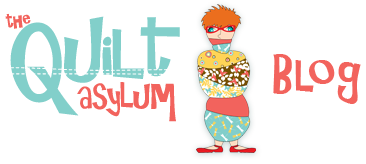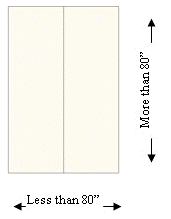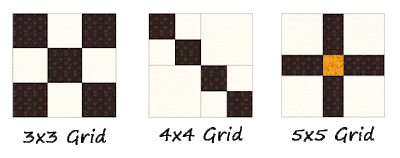If you are new to sewing, you may not realize there's a difference between a good machine and a bad machine. And if you borrowed your mother's cousin's aunt's dead grandmother's sewing machine or bought one at a Big Box retailer for under $100 to see if you like this sewing and quilting thing, you may not know much about sewing machines at all.
Sewing machines come in all shapes, sizes and price ranges. I completely understand the budgetary need to start out with a borrowed, second-hand, or discount machine. We've all had to start somewhere. But I'll tell you, a good and dependable sewing machine with a smooth stitch and great tension can make all the difference in the world in the outcome of your project. Many students in our classes become frustrated with a project and they don't understand that it's not their fault - they just have a cruddy sewing machine making things difficult.
The age of the machine doesn't matter - you don't have to go all bright, shiny and new to have a good machine. If you've inherited a machine or purchased one second-hand, the best gift you can give yourself is to take it to a reputable machine dealer and have it serviced. It will probably cost you around $100, but it could be the best $100 you ever spent. Nobody wants to spend their well-earned sewing time jacking around with a persnickety sewing machine! Save yourself a headache!
Theoretically, to piece a quilt, all your machine has to have is a nice, even, straight stitch. I know several quilters that piece masterpieces using 70 year old Singer machines. But, as time goes by, you may want to try machine quilting, or zig zag stitching or making handbags, and want a machine that does a little bit more. Or, perhaps you started with a Big Box machine and it doesn't work so well any more (and never really did....) and you're in the market for a better quality machine. How on earth do you go about choosing the right sewing machine for you?
Sewing machines are like cars or religion. There's all kinds, and sewists tend to be very brand loyal. But the things that someone loves about their machine may not make any difference to you, so their recommendation has only so much merit. You really have to think about the features you want and take multiple test drives. There are lots of choices in the marketplace, and you can be completely overwhelmed if you go to the store without a checklist. Some sewing machine dealers are like used car salesmen and will try to get you into the most expensive machine. Some are really great. Some may be educated about sewing for quilts as opposed to sewing garments or home dec, while others don't really understand the difference. Going on visits armed with basic knowledge gives you a leg up and will help you make a better informed choice. Take a deep breath, and I'll walk you through some of basic questions you should ask yourself, your friends or a dealer when you visit a sewing machine store.
Here's some of the first steps you should do and know before test driving a new machine.
1. Go ahead and ask your friends what kind of machines they have. Ask them what they like best about them and what they like the least. Remember that you may be getting a biased opinion, but you will be getting an opinion! Besides the brand, ask them WHERE they purchased their machine and if they are happy with the dealership. Buying a great machine from a dealer with poor customer service can be a major headache.
2. Make a list of sewing machine dealers in your area. You want to purchase a machine locally from someone who is convenient to you because the store where you purchase your machine is the ONLY place you can receive lessons and warranty service. You will not receive lessons or warrantied repairs from a local dealer if you purchase a machine on the internet or at a quilt show far from home. You think you're getting a great deal, but you're not. You're missing the SERVICE portion of the deal. After the warranty period on a new sewing machine has expired (usually one year), you can take it anywhere you'd like to have tune-ups and repairs made.
3. Know that there are 3 kinds of machines out there: mechanical, electronic, and computerized.
- Mechanical machines are gear driven and don't have computer chips. They are workhorse machines and have a limited number of stitches and features. You manually have to turn a dial or push a button to change stitches, and you may be limited to the sizes of stitches built into the machine. They are usually priced at the lower end of the spectrum, and the heavier they are, the better the parts are. Plastic is lighter than metal. Just sayin'. Mechanical machines are not a bad thing; they're just basic, entry-level machines.
- Electronic machines have computer chips and boards in them. They offer a wider range of stitch styles and sizes, and have features not offered on a mechanical machine. They range in price from a couple of hundred dollars up to a several thousand. The majority of the machines you will be looking at will be electronic.
- Computerized machines are also electronic, but they have the capability to be programmed to perform a task without guidance. Machines with embroidery capabilities tend to fall in this category, and pricing usually starts in the thousands. This is probably not the category you will be looking at for your first machine.
5. Think about the features you'd like your machine to have. Here are a few to consider.
- Needle Up/Down - This is an electronic feature that determines the placement of the needle when the machine stops running. Needle Down is really handy when you stop to reposition your fabric or to pivot.
- Needle Threader - This gizmo is just like it sounds; it aids in threading the needle. It's a wonderful tool for those of us with older eyes!
- Speed Control - Do you want the ability to adjust your sewing speed?
- Free Arm - If you think you might ever wish to sew clothing or handbags, you might like a Free Arm feature.
- Size of the Harp - the what? The harp is the opening of the space between the needle arm and the motor. A larger space makes machine quilting and sewing large bulky things easier.
- Feet - You are definitely going to need a 1/4" foot, and most likely a walking and/or darning foot if you're going to do any kind of machine quilting. Ask if these feet are included, and if not, how much additional cost is involved.
- Additional accessories - Extension tables and carrying cases or covers fall in this category. Are they included, and if not, how much extra cost is involved?
Now it's time to test drive. Make sure you allow yourself enough time to properly test out machines; 10 or 15 minutes is not enough time to make a decision that could last for years! Go to the dealer armed with real quilting fabrics. Most dealerships have scraps to sew on, but they are NOT quilt-weight cottons. I advise you to take pre-cut squares and strips. Ask to test drive with a 1/4" foot. Chain sew several pieces in a row to see how well the 1/4" foot feeds. Believe me when I tell you that not all 1/4" feet sit properly on the feed dogs! Take a small ruler with you and actually measure the quarter inch seam. If you already machine quilt, take a quilt sandwich with you and test that out also. If there are any other features that you are interested in, take the time to try them all out thoroughly.
Ask the dealer specifically about machine training (if you think you'll need it), warranties, and trade-in/trade-up programs offered. Ask what the typical service turn-around time is. You are interviewing the dealership itself for services as well as looking for the right machine for your needs. Hopefully, with a little bit of time and planning, you will soon own the machine of your dreams!
Buying a sewing machine doesn't have to be a scary process. Do your research, take some time, and consider carefully. Fall in love with your choice. Hopefully, the two of you will have a long and productive relationship for years to come!
























